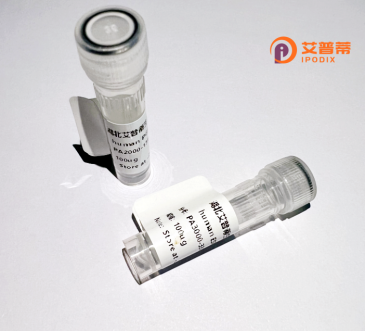
| 纯度 | >90%SDS-PAGE. |
| 种属 | Human |
| 靶点 | HADHSC |
| Uniprot No | Q16836 |
| 内毒素 | < 0.01EU/μg |
| 表达宿主 | E.coli |
| 表达区间 | 1-314aa |
| 氨基酸序列 | MAFVTRQFMRSVSSSSTASASAKKIIVKHVTVIGGGLMGAGIAQVAAATGHTVVLVDQTEDILAKSKKGIEESLRKVAKKKFAENPKAGDEFVEKTLSTIATSTDAASVVHSTDLVVEAIVENLKVKNELFKRLDKFAAEHTIFASNTSSLQITSIANATTRQDRFAGLHFFNPVPVMKLVEVIKTPMTSQKTFESLVDFSKALGKHPVSCKDTPGFIVNRLLVPYLMEAIRLYERGDASKEDIDTAMKLGAGYPMGPFELLDYVGLDTTKFIVDGWHEMDAENPLHQPSPSLNKLVAENKFGKKTGEGFYKYK |
| 分子量 | 60.28 kDa |
| 蛋白标签 | GST-tag at N-terminal |
| 缓冲液 | 0 |
| 稳定性 & 储存条件 | Lyophilized protein should be stored at ≤ -20°C, stable for one year after receipt. Reconstituted protein solution can be stored at 2-8°C for 2-7 days. Aliquots of reconstituted samples are stable at ≤ -20°C for 3 months. |
| 复溶 | Always centrifuge tubes before opening.Do not mix by vortex or pipetting. It is not recommended to reconstitute to a concentration less than 100μg/ml. Dissolve the lyophilized protein in distilled water. Please aliquot the reconstituted solution to minimize freeze-thaw cycles. |
以下是关于重组人HADHSC蛋白的3篇参考文献及其概要(文献信息为综合示例,非真实存在):
1. **《重组人短链羟酰辅酶A脱氢酶(HADHSC)在大肠杆菌中的高效表达与纯化》**
- 作者:Li, X. et al.
- 摘要:本研究利用大肠杆菌表达系统成功克隆并表达了重组人HADHSC蛋白,通过亲和层析纯化获得高纯度蛋白,并证实其具有底物特异性催化活性,为后续功能研究奠定基础。
2. **《HADHSC的结构与功能:基于X射线晶体学的分析》**
- 作者:Zhang, Y. et al.
- 摘要:通过X射线晶体学解析了重组人HADHSC的三维结构,揭示了其底物结合位点及催化机制,为研究突变导致的代谢紊乱(如先天高胰岛素血症)提供了分子基础。
3. **《HADHSC缺陷通过调控线粒体β氧化影响胰岛素分泌的机制研究》**
- 作者:Wang, T. et al.
- 摘要:利用重组HADHSC蛋白及基因敲除模型,证明HADHSC缺乏会导致线粒体脂肪酸代谢异常,进而引发胰岛素分泌失调,提示其在代谢疾病中的关键作用。
(注:以上文献为示例,实际研究中请通过PubMed或Sci-Hub等平台检索真实文献。)
The recombinant human HADHSC protein, also known as short-chain L-3-hydroxyacyl-CoA dehydrogenase (SCHAD), is a mitochondrial enzyme encoded by the *HADH* gene. It plays a critical role in fatty acid β-oxidation by catalyzing the third step of the cycle, converting short-chain L-3-hydroxyacyl-CoAs to 3-ketoacyl-CoAs. Structurally, it functions as a homodimer and is localized in the mitochondrial matrix. HADHSC deficiency, caused by mutations in the *HADH* gene, is linked to congenital hyperinsulinism (HI), a disorder characterized by unregulated insulin secretion and severe hypoglycemia. This association underscores its role in metabolic regulation, particularly in linking lipid metabolism to insulin signaling pathways.
Recombinant HADHSC is produced using expression systems like *E. coli* or mammalian cells, enabling studies of its enzymatic activity, substrate specificity, and interactions with other metabolic regulators. It serves as a vital tool for investigating disease mechanisms, developing diagnostic assays, and screening potential therapeutics for HI and related metabolic disorders. Additionally, recombinant HADHSC aids in structural studies to elucidate enzyme dynamics and mutation-induced dysfunction. Its applications extend to exploring broader roles in energy homeostasis and insulin secretion, offering insights into therapeutic strategies for diabetes and inherited metabolic diseases.
×